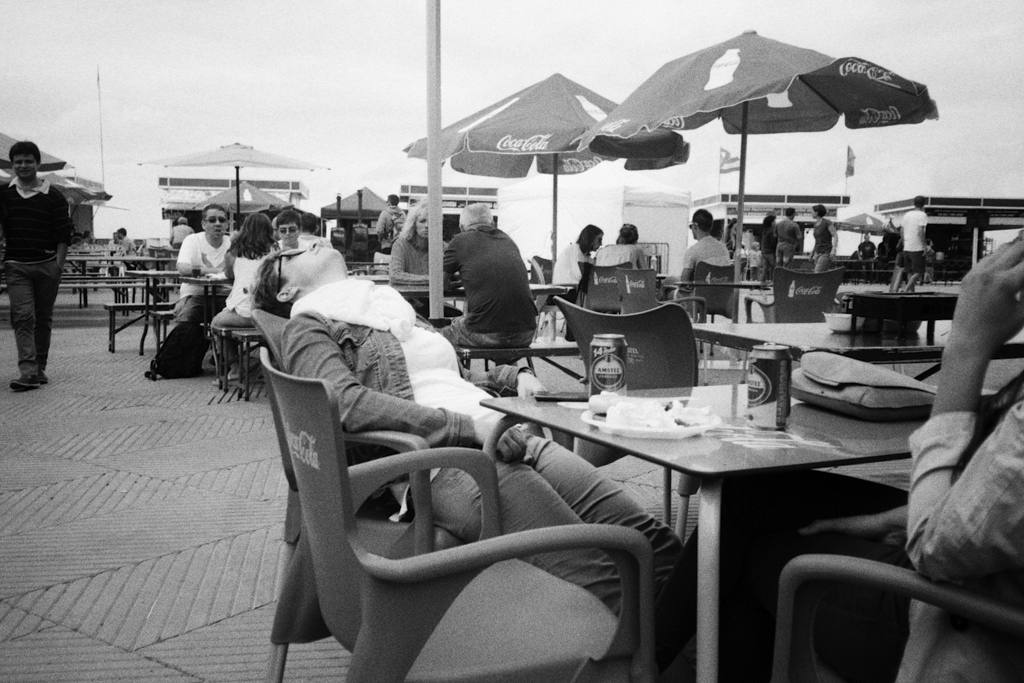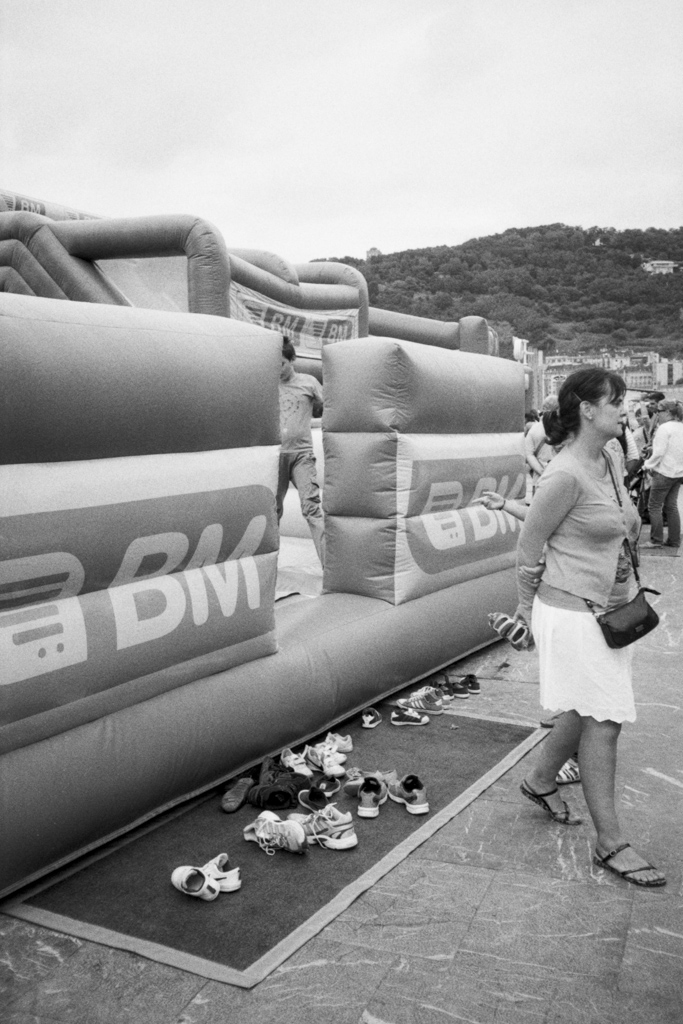The other day I developed some film in coffee for the first time. I wanted to try this for a while and had all the ingredients for stand-development sitting around with my other chemicals for a while, but somehow I never got around to it. Now I finally tried it and I have to say that I’m impressed.
For stand-development it needs four ingredients: Instant coffee – the cheaper the better -, washing soda, vitamin C and potassium bromide. If you develop slow speed films you won’t need the potassium bromide, but with high speed film this will reduce fogging and grain. Washing soda is one of these things that might be a little more difficult to obtain depending on where you are, but it is readily available in Germany and can also be bought on ebay as far as I know. This stuff is actually quite handy anyway: It’s good for cleaning and for getting stains out of laundry. In fact, ask your mom or grandma, she might have some or know where to get it. As for potassium bromide: It’s non-toxic, so it’s easily available and can be shipped by airmail. Again, I bought mine off ebay very cheaply and now I probably have enough for about 2000 rolls of film (Speaking of potassium: the Gummy Bear Appreciation Society of which I am obviously the president opposes the cruelty of youtube videos that use potassium chlorate to blow up innocent candy bears). Powdered Vitamin C is also easily available, but you have to make sure it’s unflavoured and without any added ingredients that might mess things up.
Now for the recipe: 400ml, i.e. 1 roll of film in an AP tank
- 16g instant coffee
- 6.4g washing soda
- 4g vitamin C
- 0.5g potassium bromide (KBr)
- ~ 400ml of 20°C water
As you can see, the measurements are a bit tricky if you don’t have a fine digital scale. Mine is certainly not fine enough for 0.5g and 4g vitamin C is a little tricky as well. For the potassium bromide there is a little trick that might come in handy: I dissolved 10g of potassium bromide in water to make up 100ml. 10ml of the liquid now contains 1g of potassium bromide and I measured 5ml with a medical syringe with a plastic tip to get the 0.5g of potassium bromide for the recipe. If you can measure the right amount of Rodinal, you can measure the KBr as well. Easy! And apparently the stuff keeps forever according to the online forum where I found this tip. I’ve lost the link or else I’d point you there.
To mix up the ingredients, first mix the washing soda, the vitamin C and 5ml of KBr solution with 20°C water to make up 200ml. This way you can make sure that all of it actually dissolved, which is impossible with the coffee already in the mix. Then mix the instant coffee with (cold) water to make 200ml of coffee. You have to stir properly to make sure all of the coffee dissolves. Then mix the clear solution with the coffee and you’re done. Now let this vile smelling concoction sit for about 5minutes to get rid of air bubbles. While it’s sitting you can already pre-soak the film in 20°C water. In this case pre-soaking is necessary and I always do it anyway to make sure I don’t have any cuttings from the film leader in the tank or to prevent stain from the backing paper of 120 film.
For stand-development, agitate the first 30 seconds – I swirl it like a wine glass – and then let it sit. I actually swirled for another 5 sec at halfway point in this case, because I always do that for Rodinal stand development, but it’s actually not necessary for box-speed. When the development time is over, dump the Caffenol. It’s actually all non-toxic, so there is no need to worry about the environment with this one. I would still wear gloves because this stuff stinks like hell and maybe also be careful with the KBr. Just because it’s non-toxic doesn’t mean that you should rub it in your eyes! Now, before you fix your film, you should try to get most of the Caffenol out of the tank. You should use at least three changes of water as a stop bath until the water runs clear. Between changes 30 sec agitation apparently help as well. This time I didn’t do the agitation, and indeed my fixer came out with a little brownish tint and smelling of coffee. Considering the usual smell this is definitely an improvement, but it’s probably not too good for the fixer.
These were also over-developed by about 1-1.5 stops, because I forgot to measure the water temperature and left it too long. According to Paul Sweeney, who always produces great results in Caffenol-CL and inspired me to try this, the best developing time for both K400 and Tri-X is 60min at box-speed and 70min is already a push to ISO 800. The temperature, the longer development time and the agitation at halfway point explains why the grain is a little more pronounced here than I would have expected. In this case it’s comparable to semi-stand in Rodinal. Next time I’ll be more careful with all these factors and see whether I can improve on the grain. In any case, I’m very happy with the tonality. Even over-developed these came out better than a lot of my attempts with Tetenal Ultrafin. And you know what? It definitely makes me want to buy more K400. Thanks to Paul for the inspiration and the great tips!
All pictures taken with: Olympus XA, F.Zuiko 35mm f/2.8.
Kentmere 400 semi-stand developed in Caffenol-CL, 70min.

© Lilly Schwartz 2014
Don’t bite the bear!

© Lilly Schwartz 2014
This perfectly shows off what Caffenol is capable of: Nice rich tonality and even over-developed this isn’t too grainy!

© Lilly Schwartz 2014
One of those little surfites. There are lots of them here.

© Lilly Schwartz 2014
Looks comfortable.

© Lilly Schwartz 2014

© Lilly Schwartz 2014

© Lilly Schwartz 2014

© Lilly Schwartz 2014

© Lilly Schwartz 2014
Well, it’s fun until someone cries.

© Lilly Schwartz 2014
It doesn’t look like it, but they are walking off a ledge.

© Lilly Schwartz 2014
Stealing shoes?
Nice write up! Good to know the tip about dissolving the KBr!
Thank you Colin, I’m glad you found it helpful!
Used Caffenol still has dissolved silver in it, which is toxic. Please don’t dump it down the drain. Great work. Love your photography and blog.
Thank you Randy. However, developer can’t have any appreciable amount of silver in it after use, otherwise the film wouldn’t need any fixing. It would be bad if developer would actually remove silver from the film. The fixing step is where the silver is removed and this is why spent fixer isn’t too healthy unless the silver has been recovered from it. The actual chemical in fixer is also used in pool cleaning so it’s also rather safe unless one is suffering from chemical sensitivity.